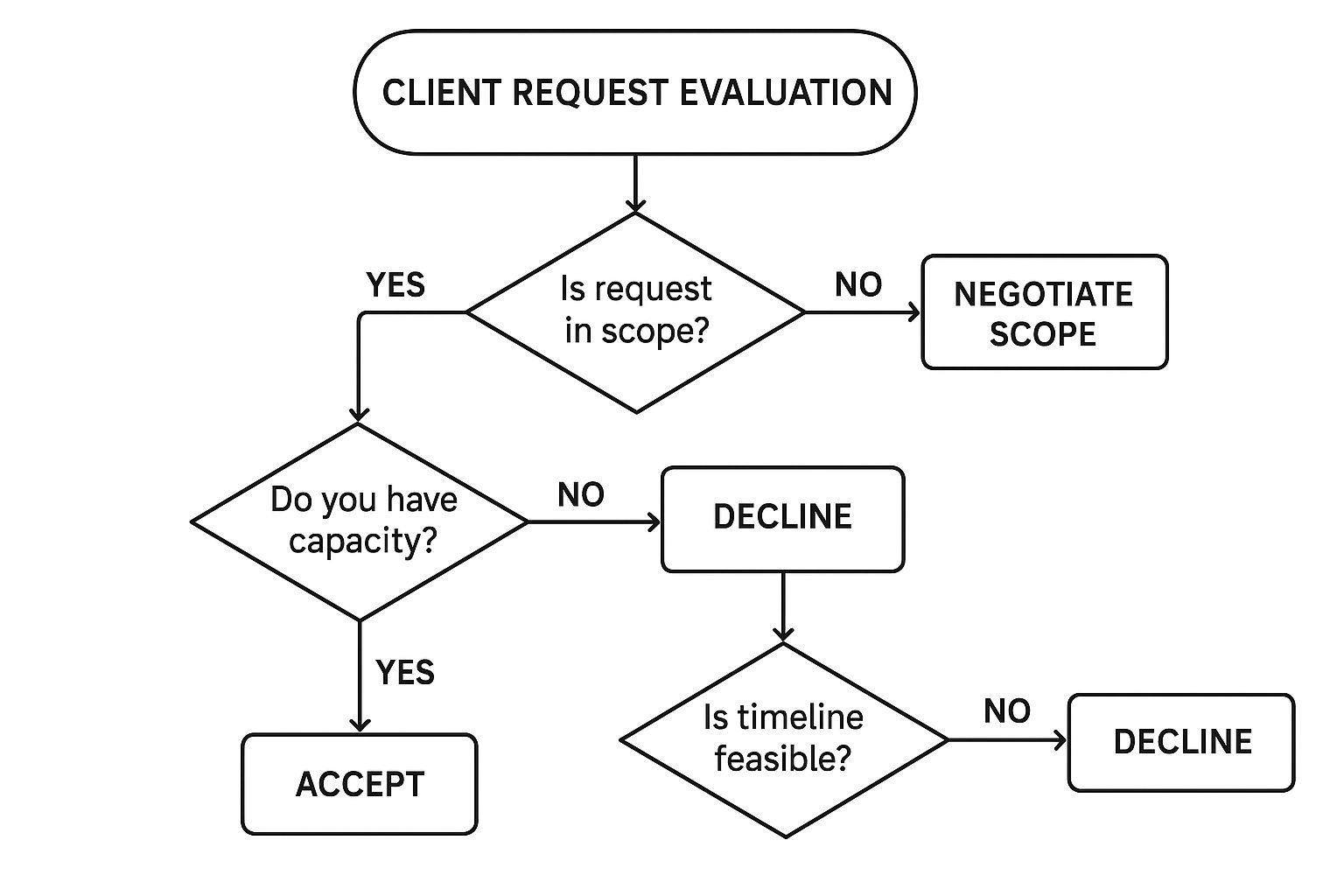Let's be real—the key to handling demanding clients isn't some secret formula. It's a blend of crystal-clear communication, rock-solid boundaries, and a knack for getting ahead of problems before they even start. Master this, and you can turn a potentially explosive situation into a stronger, more profitable relationship.
Why Demanding Clients Are the Ultimate Test for Your Business

When a demanding client lands in your inbox, it's more than just another headache. It’s a pop quiz for your entire business. These high-pressure interactions test everything—your processes, your communication chops, and frankly, your patience. How you navigate these moments says a lot about your company's professionalism and resilience.
Get it wrong, and the fallout can be serious. A poorly managed relationship doesn't just mean losing that one client's revenue. It can snowball into a damaged reputation from bad reviews or negative word-of-mouth. That's why figuring out how to deal with demanding clients is a non-negotiable skill for anyone running a service business.
Finding the Opportunity in the Chaos
I know it's easy to see these clients as nothing but trouble, but hear me out. They also present a golden opportunity to earn unshakable loyalty. Think about it: a client who feels heard and respected, even when you're disagreeing, is far more likely to stick around and become a champion for your brand. This is where you turn tough talks into trust-building moments.
Just keeping a client "satisfied" isn't enough anymore. Research keeps showing a weird gap: while customer satisfaction is holding steady, key loyalty drivers like trust and the likelihood to buy again are actually dropping. This tells us we have to do more than just the bare minimum, especially with the tough clients. For instance, the 2025 global consumer study from Qualtrics found that industries like hospitality nail this by proactively handling demands, which keeps their consumer trust high.
And let's not forget the money. Acquiring a new customer can cost six to seven times more than keeping an existing one. That alone should be all the motivation you need to manage these relationships well.
Shifting from Putting Out Fires to Preventing Them
Your ultimate goal should be to move from being reactive (constantly putting out fires) to proactive (stopping them before they spark). This comes down to a strategic mix of empathy and structure. You can absolutely validate a client’s feelings without caving to unreasonable demands.
When a demanding request hits your inbox, it's tempting to either fire back or give in immediately. Both are mistakes. Your first move should be to slow down, acknowledge, and take back control.
Here’s a quick-reference guide for that critical first response.
Your First Move with a Demanding Request
| Action | Objective | Example Phrase |
|---|---|---|
| Acknowledge and Pause | Show you've received the message and are taking it seriously, without agreeing to anything. | "Thanks for bringing this to my attention. Let me review this with my team and I'll get back to you by end of day." |
| Ask Clarifying Questions | Understand the root of the request and gather all necessary details. | "To make sure I fully understand, could you walk me through what you're hoping to achieve with this change?" |
| Re-center on the Goal | Bring the conversation back to the project's original objectives and scope. | "Let's revisit our initial goals for this project to see how this new request fits into the overall strategy we agreed on." |
These initial steps aren't about solving the problem on the spot. They’re about de-escalating the immediate tension and giving you the space to formulate a professional, strategic response.
By mastering this balance, you’ll not only calm down difficult situations but also reinforce your expertise and value. The strategies we'll cover will help you build stronger habits. For more on building positive client dynamics from the start, check out our guide on how to increase client satisfaction.
The true measure of your business isn’t how you perform when things are easy, but how you respond when a client relationship is under pressure. Every demanding client is an opportunity to prove your value and strengthen your systems.
Let’s be honest: the best way to deal with a demanding client is to stop them from becoming “demanding” in the first place.
Instead of waiting for the chaos to start, the most successful freelancers and agencies I know play offense. They get way out ahead of potential problems. This all comes down to building a rock-solid foundation of crystal-clear communication and mutual understanding from the very first hello.

Think about it. A lot of those classic "demanding" behaviors—the micromanaging, the constant "just checking in" emails—are really just symptoms of anxiety. Your client is uncertain. They're nervous. By setting clear rules of engagement right from the start, you can calm those fears before they spiral into habits that drive you crazy.
Build Your Project on a Bedrock of Documentation
Your contract and statement of work (SOW) are so much more than legal fluff. They are your absolute best friends in managing expectations. Any vagueness in your agreements is a wide-open invitation for scope creep and, eventually, conflict.
Treat your SOW like the project's constitution. It needs to be airtight, leaving zero room for interpretation. Don't just list the deliverables. Get granular. Spell out what’s included and, just as crucially, what’s not included.
A well-defined scope should get specific on things like:
- Revision Rounds: "Your project includes two full rounds of revisions on the initial design concepts. Any additional rounds after that will be billed at my hourly rate of $X."
- Communication Channels: "To keep everything organized and on the record, all project feedback and approvals need to come through our project management portal."
- Deliverable Formats: "I’ll deliver the final logo files in .AI, .EPS, .PNG, and .JPG formats."
This level of detail is your best defense against the dreaded, "Oh, I just assumed that was part of the deal" conversation. It takes a fuzzy expectation and makes it a concrete, agreed-upon fact.
A project without clear, written expectations is like building a house without a blueprint. It might stand for a while, but it’s destined to develop cracks under pressure.
The Power of the Communication Charter
Here’s a little trick I’ve used that works wonders: the Communication Charter. It’s a simple, one-page doc you go over in your kickoff meeting. It's less formal than the contract, but it's essential for setting the daily rhythm of how you'll work together.
This document answers all those practical questions that can cause friction down the line:
- Response Times: "My business hours are 9 AM to 5 PM, Monday to Friday. You can expect a response to any non-urgent emails within 24 business hours."
- Meeting Cadence: "We’ll have a quick 30-minute check-in call every Friday at 10 AM to review progress and tackle any questions."
- The Feedback Loop: "To avoid crossed wires, please consolidate all your team's feedback into a single document or message for each round."
Having these ground rules in writing makes it so much easier to handle a client who starts sending frantic texts on a Sunday night. You can gently and confidently point back to the charter you both agreed on. If you want to go deeper on this, you can explore more client communication best practices.
When you master proactive documentation and set these clear rules, you instantly shift your role. You’re no longer a reactive problem-solver; you're a strategic partner leading the engagement. This doesn’t just help you manage difficult clients—it establishes you as a professional, builds trust, and paves a much smoother road to success for everyone.
Setting Boundaries That Clients Respect

Talking the talk with clear communication is a great start, but it’s pretty meaningless if you don’t have firm boundaries to back it all up.
Let's be real: this is often the hardest part of figuring out how to deal with demanding clients. It's also where you prove the real value of your expertise and, just as importantly, your time.
This isn’t about being a brick wall or coming across as unhelpful. It's about professionally training your clients on how to get the best results with you. When you let your boundaries get fuzzy, you’re basically sending an open invitation for chaos to crash your workflow. That doesn't help anyone.
Learning to Say No Gracefully
Saying "no" can feel awkward, especially when you want to be accommodating. But trust me, it’s one of the most important skills you can develop in business. The secret is to decline the request, not the person. Always frame your "no" in a way that protects the project's quality and the commitments you've already made. You can be firm and kind at the same time.
Picture this: It's 7 PM and an email dings. A client needs an "urgent" new graphic for the next morning. Instead of either scrambling to get it done or shooting back an annoyed reply, try a more strategic approach.
"Thanks for sending this over! I've logged it for tomorrow morning. Since this is a new request outside our original scope, I'll review it first thing and send over a timeline and a separate quote. I'm committed to our current deliverables, and this ensures they stay on track."
This response is a masterclass in boundary-setting. It acknowledges their need, clearly states when you'll address it (during business hours), and reinforces the project scope without a hint of confrontation. It’s how you gently nudge clients back inside the lines you drew at the beginning.
Defending Your Time and Channels
Your time is your most valuable—and most finite—asset. The moment clients start hitting you up on personal channels or expecting you to be on-call during the weekend, you need to redirect them. Do it politely, but do it immediately. A lack of boundaries here is a fast track to burnout and resentment.
The financial fallout from mismanaging demanding clients is pretty staggering. Poor customer service costs U.S. companies around $75 billion every single year. And while only 25% of call centers have brought in AI for support, the human element remains critical. For instance, 76% of employees feel more engaged when their leaders show empathy—a trait that's essential when you're enforcing boundaries firmly but fairly.
Here are a few classic boundary-crossing moves and how to handle them like a pro:
- The Weekend Request: An email comes in on a Saturday. If it's not a true emergency, just wait until Monday morning to reply. Your silence sends a clear message about your working hours.
- The "Just One More Thing" Add-on: When a client tries to sneak in extra work, respond with positivity, but hold your ground. Try something like, "That's a great idea! It falls just outside our current project, but I’d be happy to scope it out as a separate task." You can find more tips on this in our detailed guide to managing project scope creep.
- The Manipulative Tactic: Every once in a while, you might encounter a client who uses guilt or pressure to get what they want. Being capable of understanding emotional manipulation and narcissism in professional interactions is a huge advantage in navigating these difficult situations.
When you consistently enforce your agreements, you're showing clients that you're a serious professional who respects your own business. It might feel counterintuitive, but over time, this doesn't push good clients away. It makes them respect you even more.
Even with the best game plan and the clearest boundaries, things can still go sideways with a client. It happens. A project hits an unexpected snag, a simple miscommunication spirals, and suddenly you’re in a tense situation. It’s easy to get defensive and fall into a blame game.
But here’s the thing: your goal isn't to win the argument. It's to steer the ship back to a productive partnership.
The trick is to pivot the conversation from a fight to a collaboration. This starts with one of the most powerful—and most overlooked—tools you have: simply listening.
When a client is upset, what they really want is to feel heard. Before you jump in with solutions or try to defend your work, just give them the floor. Let them get it all out without interruption. Your only job in that moment is to listen. This one move can instantly diffuse the tension and shows you respect their perspective, which is absolutely critical for de-escalation.
From Acknowledgment to Action
Okay, so you’ve listened. Now what? The next step is to validate their feelings. And no, that's not the same as agreeing with them or admitting you messed up. You're just showing them you understand why they're frustrated, without caving to demands.
A few simple phrases can work wonders here.
- "I can see why that would be so frustrating. It sounds like we missed the mark here, and I completely understand why you're upset."
- "Thank you for being so upfront about this. I really appreciate you bringing it to my attention so we can figure out a path forward together."
See the shift? You’ve gone from being their adversary to their ally. Once a client feels heard, they become way more open to actually solving the problem with you. Making clients feel seen is more important than ever. In fact, a good customer experience is a major reason why 73% of people make a purchase. The whole game is moving toward more personalized service, which is why it's so helpful to understand what customers are looking for. You can read more about these evolving customer experience statistics on Notta.ai to get a feel for the landscape.
Document and Propose a Fix
Once the emotional storm has calmed, it's time to get objective. Your next move is to document the issue clearly and without pointing fingers. A simple, factual summary gets everyone on the same page.
For instance, after a fiery phone call, you might send a follow-up email that goes something like this:
"Hi [Client Name], thanks for the chat earlier. Just to recap, the main issue is that the social media graphics we delivered didn't quite match the campaign's visual style. My understanding is we need to adjust the color palette and fonts to better align with the new branding guide. Please let me know if I've missed anything."
This creates a clear paper trail and smoothly transitions the conversation toward what’s next.
From here, you can propose a solution that fixes their problem while still protecting your own time and resources. Instead of asking, "So, what do you want me to do?"—which puts all the power in their hands—lead with a concrete plan. Offer one or two clear options you can realistically deliver, framing it as a team effort to get the project back on track.
This approach doesn't just put out a fire; it turns a potential crisis into a chance to show off your problem-solving skills and prove just how valuable you really are.
Sometimes, no matter what you do, a client relationship just isn't working.
You've tried setting boundaries. You’ve had the tough conversations. But the constant stress, the disrespect, or the never-ending scope creep is costing you more than just money—it's costing you your peace of mind.
Knowing when to walk away is one of the most powerful skills you can develop as a freelancer or agency owner. It’s not about giving up; it’s about protecting your business and, frankly, your sanity.
If a client consistently shows toxic behavior, the relationship is probably past the point of no return. We’re not talking about one off-day or a single miscommunication. We’re talking about a clear pattern of destructive interactions that saps your energy and drains your team's morale.
Red Flags That Scream "It's Time to Go"
Pay attention to these warning signs. If you find yourself nodding your head to more than one of these, it’s a pretty strong signal that it's time to end things.
- They're Constantly Disrespectful: This isn't just a bad mood. It's yelling, belittling your expertise, or making demands that show zero regard for your time or well-established process.
- They're Allergic to Paying on Time: A client who consistently ghosts your invoices isn't just "forgetful." They're showing a fundamental lack of respect for the work you do and your financial stability.
- The Scope Creep is Unstoppable: They keep pushing for more and more work without ever wanting to pay for it, completely ignoring the contract and the boundaries you've tried to set.
- The Emotional Toll is Too High: This is the big one. You dread their emails. Your team tenses up when their name appears. The stress from this one client is spilling over into your other projects and even your personal life.
When these behaviors are the norm, the partnership is broken. Firing a client isn't a failure—it's a smart, strategic business decision.
I used to think I had to salvage every client relationship. But you have to think of it like pruning a tree. You're cutting off a dead branch that's draining all the energy, which lets the rest of your business grow stronger and healthier.
The Professional Breakup Plan
Once you've made the call, the goal is to end things cleanly and professionally to avoid any unnecessary drama. You need to be firm, clear, and brief. This isn't the time for a long, emotional saga or a laundry list of every little thing they did wrong.
Here’s how you handle the process without burning bridges unnecessarily:
- Draft a Simple Termination Notice: Keep it short and to the point. State that you're ending the partnership, reference the termination clause in your contract, and give them a clear end date. That's it.
- Organize a Smooth Handoff: Get all the completed work, files, and assets organized and ready to deliver. Your aim is to make their transition to a new provider as smooth as you can. This leaves no loose ends for them to complain about later.
- Send the Final Invoice: Issue one last, itemized invoice for all work completed up to the termination date. Make the payment deadline crystal clear.
Remember, letting go of a bad client creates space for a great one. It frees you up to find better partners who actually value what you bring to the table. Learning how to get freelance clients who are a much better fit is the perfect next step toward building a business you actually enjoy running.
Answering Your Questions About Demanding Clients
Even with the best strategies in place, you're going to hit some weird, specific roadblocks with demanding clients. It just happens. Let's walk through a few of the most common questions I hear from freelancers and agency owners. Think of these as quick, practical answers for situations you'll almost certainly face.
What If a Client Ignores My Business Hours?
This one's a classic. A client keeps pinging you at 10 PM or on a Sunday morning.
The first time it happens, don't make a big deal out of it. Just wait and respond during your next business day. A simple, "Thanks for your message! Just a heads-up, my office hours are 9-5, but I'm on it now," usually does the trick. It's gentle but clear.
If it keeps happening, though, it’s time for a more direct chat. Explain that sticking to business hours helps you stay focused and produce your best work for all your clients, including them. Consistency is your friend here. If you always respond within your stated hours, they'll eventually get the message.
How Do I Charge for Out-of-Scope Work?
Ah, the dreaded "scope creep." The key is to handle this with positivity, not confrontation.
When they bring up a new idea, acknowledge it as a good one. This validates their thinking and shows you're on their team. You could say something like, "That's a fantastic idea! It falls just outside our current project scope, but I'd be happy to draft a separate estimate for you."
This little script does three things at once: it avoids an argument, reinforces that you're a collaborative partner, and, most importantly, protects your time and profitability.
To make these decisions easier in the heat of the moment, it helps to have a mental flowchart. This infographic breaks down a simple way to evaluate any new request.

As you can see, the decision should always circle back to the project scope, your capacity, and the timeline—not pressure from the client. Taking the emotion out of it helps you make sound business decisions every single time.
Can a Demanding Client Become a Good One?
Yes, absolutely. But it all comes down to why they're demanding in the first place.
If their behavior is rooted in anxiety or just not understanding the project, then your proactive communication and firm boundaries can totally turn the relationship around. But if their demands come from a place of fundamental disrespect for you or your work, it’s usually better to just part ways professionally.
The key is to assess if their behavior improves once you implement new strategies. If it does, you have a partner you can work with. If not, you have your answer.
Turning a tough client into a great one is a huge part of building a sustainable business. You can dive deeper into this with our guide on how to retain clients. For more modern approaches, it's also worth exploring how AI can empower customer support to handle routine interactions, which frees you up to focus on the bigger picture.

